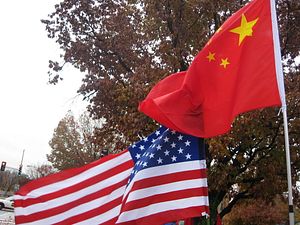In Washington, the rivalry between the United States and China is clear. As the U.S. National Security Strategy released in December 2017 sets forth, China actively challenges U.S. power and attempts to erode American security and prosperity. Washington has therefore hardened its stance toward Beijing, and not only with U.S. military posturing. The ongoing trade dispute, too, should be viewed as one part of a set of policies aimed at checking Beijing’s malign actions and ambitions abroad.
But the stakes are not yet clear to many Americans. A report published this month by the Chicago Council on Global Affairs regarding trade between China and the United States found that nearly three-quarters of Americans support engaging in trade with China, and a majority oppose tariffs on Chinese goods. Also released this month, the 2019 Chicago Council Survey revealed that 68 percent of Americans prefer to undertake friendly cooperation and engagement with China, rather than actively working to limit the growth of China’s power.
That lack of worry is surprising given that national economies underscore the national security landscape. This is not to say that trade with China isn’t valuable to the United States, but instead that trade must be fair and built on a broader rules-based system. All too often in recent years, unfair trade with China has enabled corrupt diplomacy and military build-ups by Beijing that increasingly challenge global peace and stability. Without a shadow of a doubt, Beijing is the number one national security threat to the United States over the medium-to-long term. All Americans must be realistic about the antagonistic way China has been and is continuing to conduct itself across the world.
Beijing’s most important priorities are the survival of the Chinese Communist Party (CCP) and the further development of its “One China” policy. In recent weeks, these priorities have come under increased scrutiny with the protests in Hong Kong and with rhetoric from Taiwan that Taipei is not changing its tone on independence from China. These developments have only added fuel to the political fire of the CCP and given Beijing even more reason to continue an aggressive plan to ensure its two most important priorities remain intact. China’s plan includes systematically setting the stage to put it in an advantageous position to disrupt the current international norms both near and far.
Over the last few decades, China artfully intertwined its economy within the G-20, bought U.S. debt by the boatload, became a member of the World Trade Organization, and subsequently took advantage of the economic ecosystem through a variety of unethical tactics. Additionally, since the introduction of the Belt and Road Initiative (BRI) in 2013, China has increased its international partnerships and built economic infrastructure throughout the world. These initiatives are further creating a global economic interdependence on Beijing.
China is also growing its military posture through a series of advanced Anti-Access/Area Denial weapons systems, platforms, and techniques. These include H-6K long-range strategic bombers and the DF21 which allows Beijing to threaten its neighbors and strike at long ranges from its coastline. Furthermore, Beijing rejected the July 2016 UNCLOS ruling that found its nine-dash line and historic claims in the South China Sea to be illegal and instead continues to build military facilities in the Spratly and Paracel Islands.
Further from home, China is increasing its diplomatic and military cooperation with Russia and challenging U.S. interests. A few examples include China-Russia cooperation in the Middle East, in bilateral military exercises, and in aggressive military maneuvers against U.S. and NATO air-and-sea platforms in the Pacific, the Arctic, and the Baltic Sea. James Stavridis, a retired U.S. Navy admiral and former supreme allied commander of NATO, recently wrote that “This coalescing, possibly resulting in a unified block that dominates the Eurasian continent, may be the most important geopolitical trend of the 21st century.”
Although China’s multi-pronged strategy will take time to play out, if left unchallenged, Beijing will undoubtedly achieve its goals. As a result, the CCP will feel emboldened to make strategic decisions that challenge current international rules and norms, putting at risk long-standing politics on Hong Kong and Taiwan.
The international community, to include the United States, has not done enough over the past decade to deter China’s more disruptive aims. For instance, with regard to China’s defensive posture and territorial expansion, although Washington has long asserted that these are illegal build-ups and has continuously conducted freedom of navigation operations, the efforts have not been enough to meaningfully discourage Beijing.
Therefore, in addition to increasing military pressure, economic tools are just another way the United States can check China’s strategic path. Washington would do well to look beyond the short-term effects, which are real, to nonetheless fully appreciate the strategic significance of such actions and their ability to disrupt and diminish long-term Chinese goals.
And policies are working. As recently as August 9, 2019, the International Monetary Fund said in its Article IV consultation on China’s economy that if trade tensions with the United States are not quickly resolved, it could significantly impair China’s future progress. The resulting economic impairment will result in Beijing being forced to make tougher strategic decisions, such as reigning in military spending and debt-trap infrastructure loans abroad.
In all, Americans should not view the trade war as entirely separate from U.S. efforts to confront Chinese aggression abroad. U.S. trade pressures on China are part of a broader strategy that includes the four elements of the DIME (Diplomacy, Information, Military, Economics) model to contain Chinese belligerence and protect US national security interests. Public support from both sides of the aisle is needed so that policy makers can effectively execute this strategy.
Lieutenant Commander Matthew Dalton, U.S. Navy, is a Federal Executive Fellow at the Chicago Council on Global Affairs in Chicago, IL. The views expressed herein are those of the author and do not reflect the official policy or position of the U.S. Navy, U.S. Department of Defense, or the U.S. Government.

































